University Massage Therapy Report: Stages of Healing Process
VerifiedAdded on 2020/05/28
|8
|1560
|136
Report
AI Summary
This report provides a detailed overview of the stages of healing associated with massage therapy. It breaks down the healing process into three distinct phases: the acute (inflammatory) phase, the subacute (repair and remodeling) phase, and the chronic (return to function) phase. The report explains the physiological processes occurring in each stage, including the body's inflammatory response, tissue repair mechanisms, and the remodeling of collagen fibers. It also highlights the benefits of massage therapy in each phase, such as reducing swelling, promoting circulation, relieving pain, and aiding in the alignment of collagen fibers. The report emphasizes the importance of understanding these stages for effective injury rehabilitation and the restoration of optimal function. It also references several key sources such as Salvo (2015), Lori and Hall (2005), and Field (2014) to support its claims. The report concludes with a summary of how massage therapy supports the healing process by facilitating a shift to a parasympathetic nervous response.

1Running head: MASSAGE THERAPY
Massage Therapy
Name of student:
Name of university:
Author note:
Massage Therapy
Name of student:
Name of university:
Author note:
Paraphrase This Document
Need a fresh take? Get an instant paraphrase of this document with our AI Paraphraser
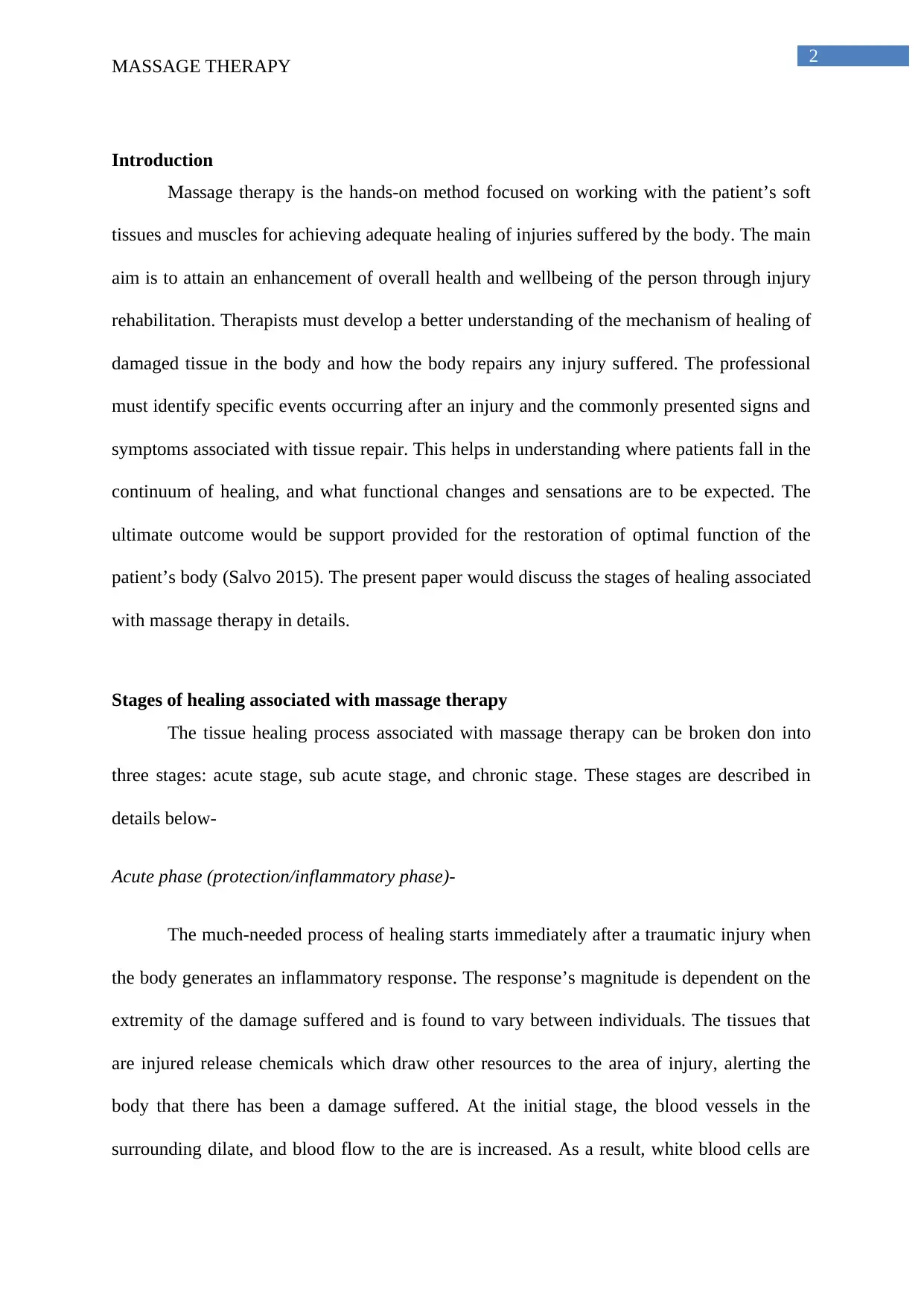
2
MASSAGE THERAPY
Introduction
Massage therapy is the hands-on method focused on working with the patient’s soft
tissues and muscles for achieving adequate healing of injuries suffered by the body. The main
aim is to attain an enhancement of overall health and wellbeing of the person through injury
rehabilitation. Therapists must develop a better understanding of the mechanism of healing of
damaged tissue in the body and how the body repairs any injury suffered. The professional
must identify specific events occurring after an injury and the commonly presented signs and
symptoms associated with tissue repair. This helps in understanding where patients fall in the
continuum of healing, and what functional changes and sensations are to be expected. The
ultimate outcome would be support provided for the restoration of optimal function of the
patient’s body (Salvo 2015). The present paper would discuss the stages of healing associated
with massage therapy in details.
Stages of healing associated with massage therapy
The tissue healing process associated with massage therapy can be broken don into
three stages: acute stage, sub acute stage, and chronic stage. These stages are described in
details below-
Acute phase (protection/inflammatory phase)-
The much-needed process of healing starts immediately after a traumatic injury when
the body generates an inflammatory response. The response’s magnitude is dependent on the
extremity of the damage suffered and is found to vary between individuals. The tissues that
are injured release chemicals which draw other resources to the area of injury, alerting the
body that there has been a damage suffered. At the initial stage, the blood vessels in the
surrounding dilate, and blood flow to the are is increased. As a result, white blood cells are
MASSAGE THERAPY
Introduction
Massage therapy is the hands-on method focused on working with the patient’s soft
tissues and muscles for achieving adequate healing of injuries suffered by the body. The main
aim is to attain an enhancement of overall health and wellbeing of the person through injury
rehabilitation. Therapists must develop a better understanding of the mechanism of healing of
damaged tissue in the body and how the body repairs any injury suffered. The professional
must identify specific events occurring after an injury and the commonly presented signs and
symptoms associated with tissue repair. This helps in understanding where patients fall in the
continuum of healing, and what functional changes and sensations are to be expected. The
ultimate outcome would be support provided for the restoration of optimal function of the
patient’s body (Salvo 2015). The present paper would discuss the stages of healing associated
with massage therapy in details.
Stages of healing associated with massage therapy
The tissue healing process associated with massage therapy can be broken don into
three stages: acute stage, sub acute stage, and chronic stage. These stages are described in
details below-
Acute phase (protection/inflammatory phase)-
The much-needed process of healing starts immediately after a traumatic injury when
the body generates an inflammatory response. The response’s magnitude is dependent on the
extremity of the damage suffered and is found to vary between individuals. The tissues that
are injured release chemicals which draw other resources to the area of injury, alerting the
body that there has been a damage suffered. At the initial stage, the blood vessels in the
surrounding dilate, and blood flow to the are is increased. As a result, white blood cells are
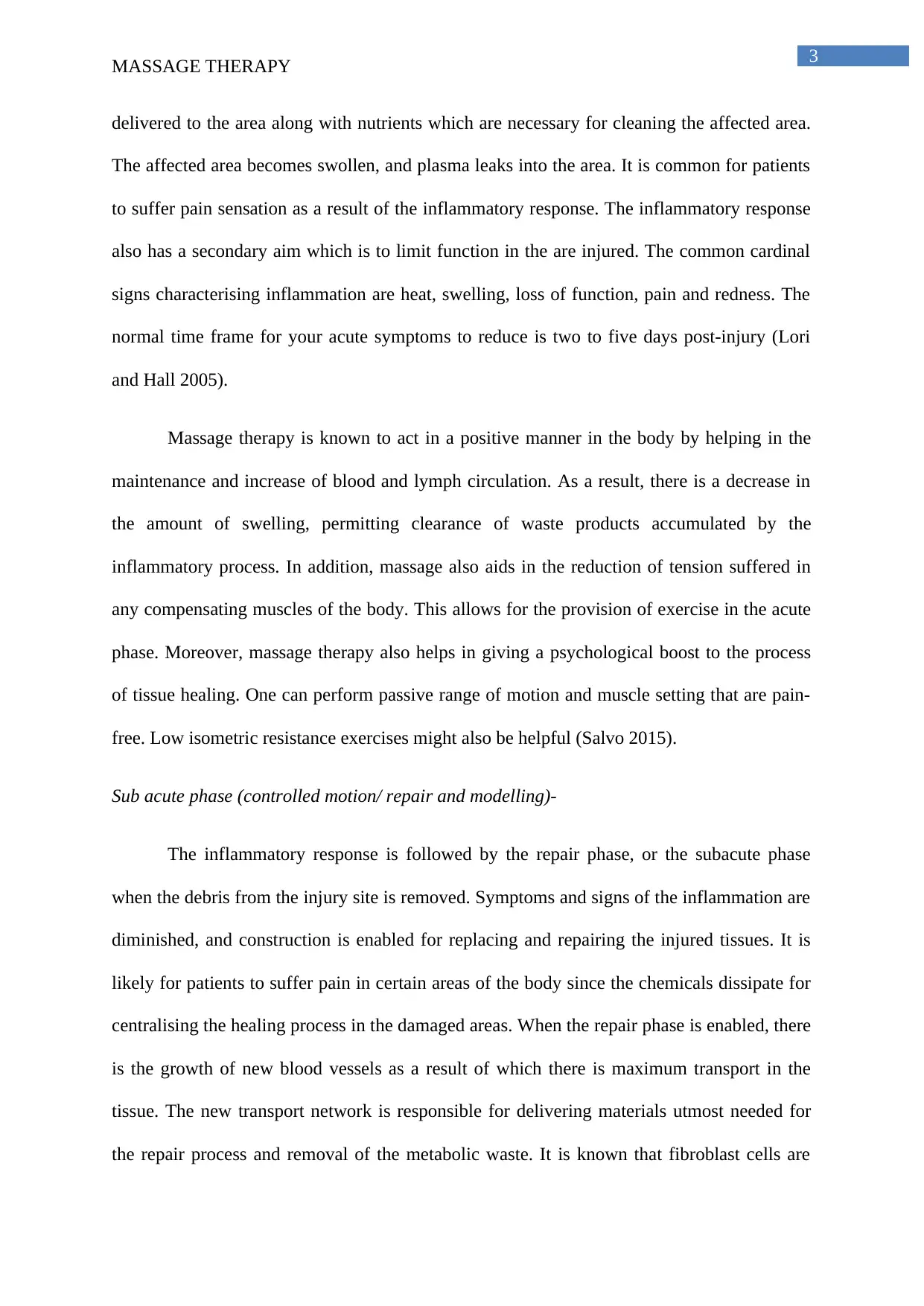
3
MASSAGE THERAPY
delivered to the area along with nutrients which are necessary for cleaning the affected area.
The affected area becomes swollen, and plasma leaks into the area. It is common for patients
to suffer pain sensation as a result of the inflammatory response. The inflammatory response
also has a secondary aim which is to limit function in the are injured. The common cardinal
signs characterising inflammation are heat, swelling, loss of function, pain and redness. The
normal time frame for your acute symptoms to reduce is two to five days post-injury (Lori
and Hall 2005).
Massage therapy is known to act in a positive manner in the body by helping in the
maintenance and increase of blood and lymph circulation. As a result, there is a decrease in
the amount of swelling, permitting clearance of waste products accumulated by the
inflammatory process. In addition, massage also aids in the reduction of tension suffered in
any compensating muscles of the body. This allows for the provision of exercise in the acute
phase. Moreover, massage therapy also helps in giving a psychological boost to the process
of tissue healing. One can perform passive range of motion and muscle setting that are pain-
free. Low isometric resistance exercises might also be helpful (Salvo 2015).
Sub acute phase (controlled motion/ repair and modelling)-
The inflammatory response is followed by the repair phase, or the subacute phase
when the debris from the injury site is removed. Symptoms and signs of the inflammation are
diminished, and construction is enabled for replacing and repairing the injured tissues. It is
likely for patients to suffer pain in certain areas of the body since the chemicals dissipate for
centralising the healing process in the damaged areas. When the repair phase is enabled, there
is the growth of new blood vessels as a result of which there is maximum transport in the
tissue. The new transport network is responsible for delivering materials utmost needed for
the repair process and removal of the metabolic waste. It is known that fibroblast cells are
MASSAGE THERAPY
delivered to the area along with nutrients which are necessary for cleaning the affected area.
The affected area becomes swollen, and plasma leaks into the area. It is common for patients
to suffer pain sensation as a result of the inflammatory response. The inflammatory response
also has a secondary aim which is to limit function in the are injured. The common cardinal
signs characterising inflammation are heat, swelling, loss of function, pain and redness. The
normal time frame for your acute symptoms to reduce is two to five days post-injury (Lori
and Hall 2005).
Massage therapy is known to act in a positive manner in the body by helping in the
maintenance and increase of blood and lymph circulation. As a result, there is a decrease in
the amount of swelling, permitting clearance of waste products accumulated by the
inflammatory process. In addition, massage also aids in the reduction of tension suffered in
any compensating muscles of the body. This allows for the provision of exercise in the acute
phase. Moreover, massage therapy also helps in giving a psychological boost to the process
of tissue healing. One can perform passive range of motion and muscle setting that are pain-
free. Low isometric resistance exercises might also be helpful (Salvo 2015).
Sub acute phase (controlled motion/ repair and modelling)-
The inflammatory response is followed by the repair phase, or the subacute phase
when the debris from the injury site is removed. Symptoms and signs of the inflammation are
diminished, and construction is enabled for replacing and repairing the injured tissues. It is
likely for patients to suffer pain in certain areas of the body since the chemicals dissipate for
centralising the healing process in the damaged areas. When the repair phase is enabled, there
is the growth of new blood vessels as a result of which there is maximum transport in the
tissue. The new transport network is responsible for delivering materials utmost needed for
the repair process and removal of the metabolic waste. It is known that fibroblast cells are
⊘ This is a preview!⊘
Do you want full access?
Subscribe today to unlock all pages.

Trusted by 1+ million students worldwide
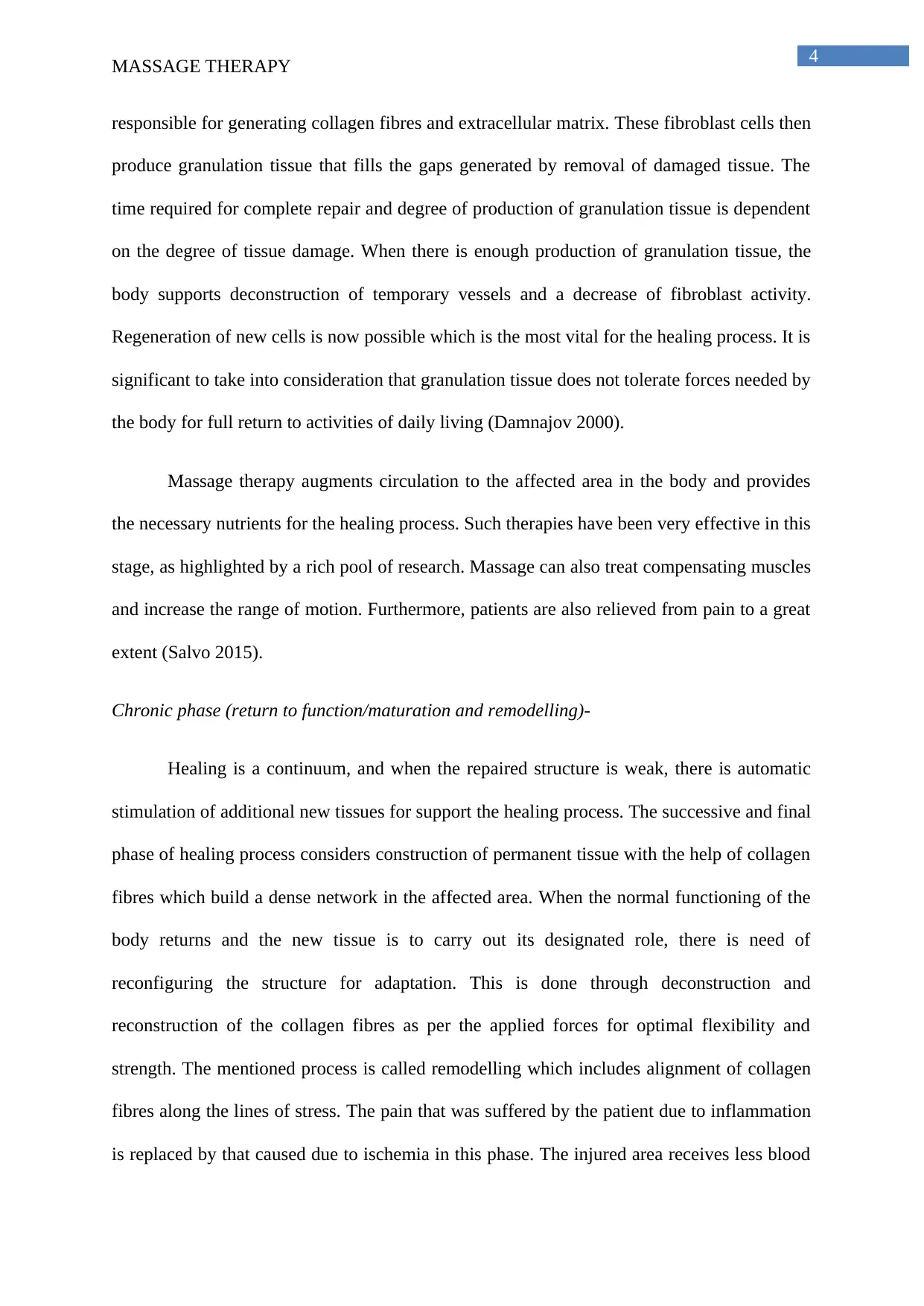
4
MASSAGE THERAPY
responsible for generating collagen fibres and extracellular matrix. These fibroblast cells then
produce granulation tissue that fills the gaps generated by removal of damaged tissue. The
time required for complete repair and degree of production of granulation tissue is dependent
on the degree of tissue damage. When there is enough production of granulation tissue, the
body supports deconstruction of temporary vessels and a decrease of fibroblast activity.
Regeneration of new cells is now possible which is the most vital for the healing process. It is
significant to take into consideration that granulation tissue does not tolerate forces needed by
the body for full return to activities of daily living (Damnajov 2000).
Massage therapy augments circulation to the affected area in the body and provides
the necessary nutrients for the healing process. Such therapies have been very effective in this
stage, as highlighted by a rich pool of research. Massage can also treat compensating muscles
and increase the range of motion. Furthermore, patients are also relieved from pain to a great
extent (Salvo 2015).
Chronic phase (return to function/maturation and remodelling)-
Healing is a continuum, and when the repaired structure is weak, there is automatic
stimulation of additional new tissues for support the healing process. The successive and final
phase of healing process considers construction of permanent tissue with the help of collagen
fibres which build a dense network in the affected area. When the normal functioning of the
body returns and the new tissue is to carry out its designated role, there is need of
reconfiguring the structure for adaptation. This is done through deconstruction and
reconstruction of the collagen fibres as per the applied forces for optimal flexibility and
strength. The mentioned process is called remodelling which includes alignment of collagen
fibres along the lines of stress. The pain that was suffered by the patient due to inflammation
is replaced by that caused due to ischemia in this phase. The injured area receives less blood
MASSAGE THERAPY
responsible for generating collagen fibres and extracellular matrix. These fibroblast cells then
produce granulation tissue that fills the gaps generated by removal of damaged tissue. The
time required for complete repair and degree of production of granulation tissue is dependent
on the degree of tissue damage. When there is enough production of granulation tissue, the
body supports deconstruction of temporary vessels and a decrease of fibroblast activity.
Regeneration of new cells is now possible which is the most vital for the healing process. It is
significant to take into consideration that granulation tissue does not tolerate forces needed by
the body for full return to activities of daily living (Damnajov 2000).
Massage therapy augments circulation to the affected area in the body and provides
the necessary nutrients for the healing process. Such therapies have been very effective in this
stage, as highlighted by a rich pool of research. Massage can also treat compensating muscles
and increase the range of motion. Furthermore, patients are also relieved from pain to a great
extent (Salvo 2015).
Chronic phase (return to function/maturation and remodelling)-
Healing is a continuum, and when the repaired structure is weak, there is automatic
stimulation of additional new tissues for support the healing process. The successive and final
phase of healing process considers construction of permanent tissue with the help of collagen
fibres which build a dense network in the affected area. When the normal functioning of the
body returns and the new tissue is to carry out its designated role, there is need of
reconfiguring the structure for adaptation. This is done through deconstruction and
reconstruction of the collagen fibres as per the applied forces for optimal flexibility and
strength. The mentioned process is called remodelling which includes alignment of collagen
fibres along the lines of stress. The pain that was suffered by the patient due to inflammation
is replaced by that caused due to ischemia in this phase. The injured area receives less blood
Paraphrase This Document
Need a fresh take? Get an instant paraphrase of this document with our AI Paraphraser
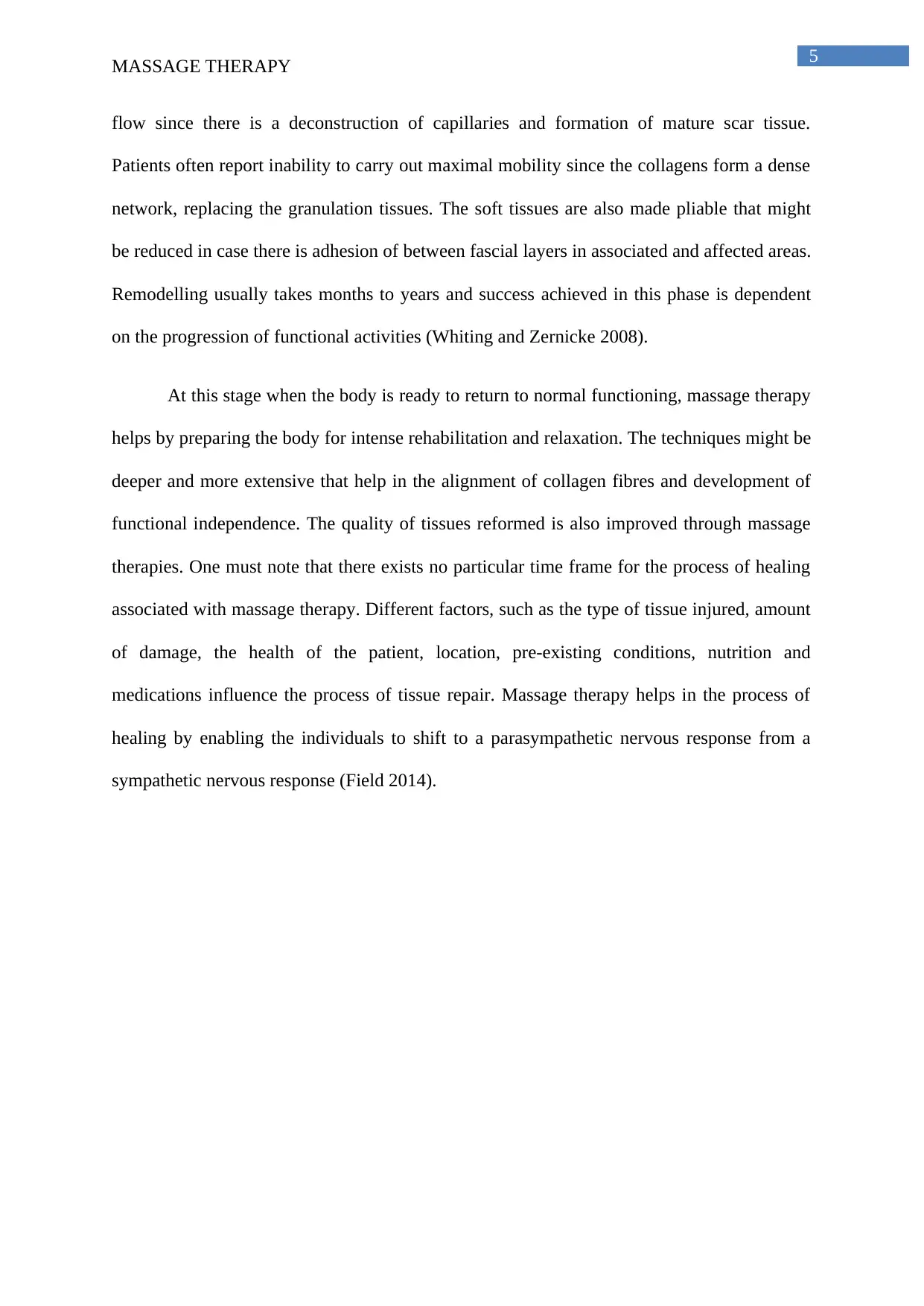
5
MASSAGE THERAPY
flow since there is a deconstruction of capillaries and formation of mature scar tissue.
Patients often report inability to carry out maximal mobility since the collagens form a dense
network, replacing the granulation tissues. The soft tissues are also made pliable that might
be reduced in case there is adhesion of between fascial layers in associated and affected areas.
Remodelling usually takes months to years and success achieved in this phase is dependent
on the progression of functional activities (Whiting and Zernicke 2008).
At this stage when the body is ready to return to normal functioning, massage therapy
helps by preparing the body for intense rehabilitation and relaxation. The techniques might be
deeper and more extensive that help in the alignment of collagen fibres and development of
functional independence. The quality of tissues reformed is also improved through massage
therapies. One must note that there exists no particular time frame for the process of healing
associated with massage therapy. Different factors, such as the type of tissue injured, amount
of damage, the health of the patient, location, pre-existing conditions, nutrition and
medications influence the process of tissue repair. Massage therapy helps in the process of
healing by enabling the individuals to shift to a parasympathetic nervous response from a
sympathetic nervous response (Field 2014).
MASSAGE THERAPY
flow since there is a deconstruction of capillaries and formation of mature scar tissue.
Patients often report inability to carry out maximal mobility since the collagens form a dense
network, replacing the granulation tissues. The soft tissues are also made pliable that might
be reduced in case there is adhesion of between fascial layers in associated and affected areas.
Remodelling usually takes months to years and success achieved in this phase is dependent
on the progression of functional activities (Whiting and Zernicke 2008).
At this stage when the body is ready to return to normal functioning, massage therapy
helps by preparing the body for intense rehabilitation and relaxation. The techniques might be
deeper and more extensive that help in the alignment of collagen fibres and development of
functional independence. The quality of tissues reformed is also improved through massage
therapies. One must note that there exists no particular time frame for the process of healing
associated with massage therapy. Different factors, such as the type of tissue injured, amount
of damage, the health of the patient, location, pre-existing conditions, nutrition and
medications influence the process of tissue repair. Massage therapy helps in the process of
healing by enabling the individuals to shift to a parasympathetic nervous response from a
sympathetic nervous response (Field 2014).
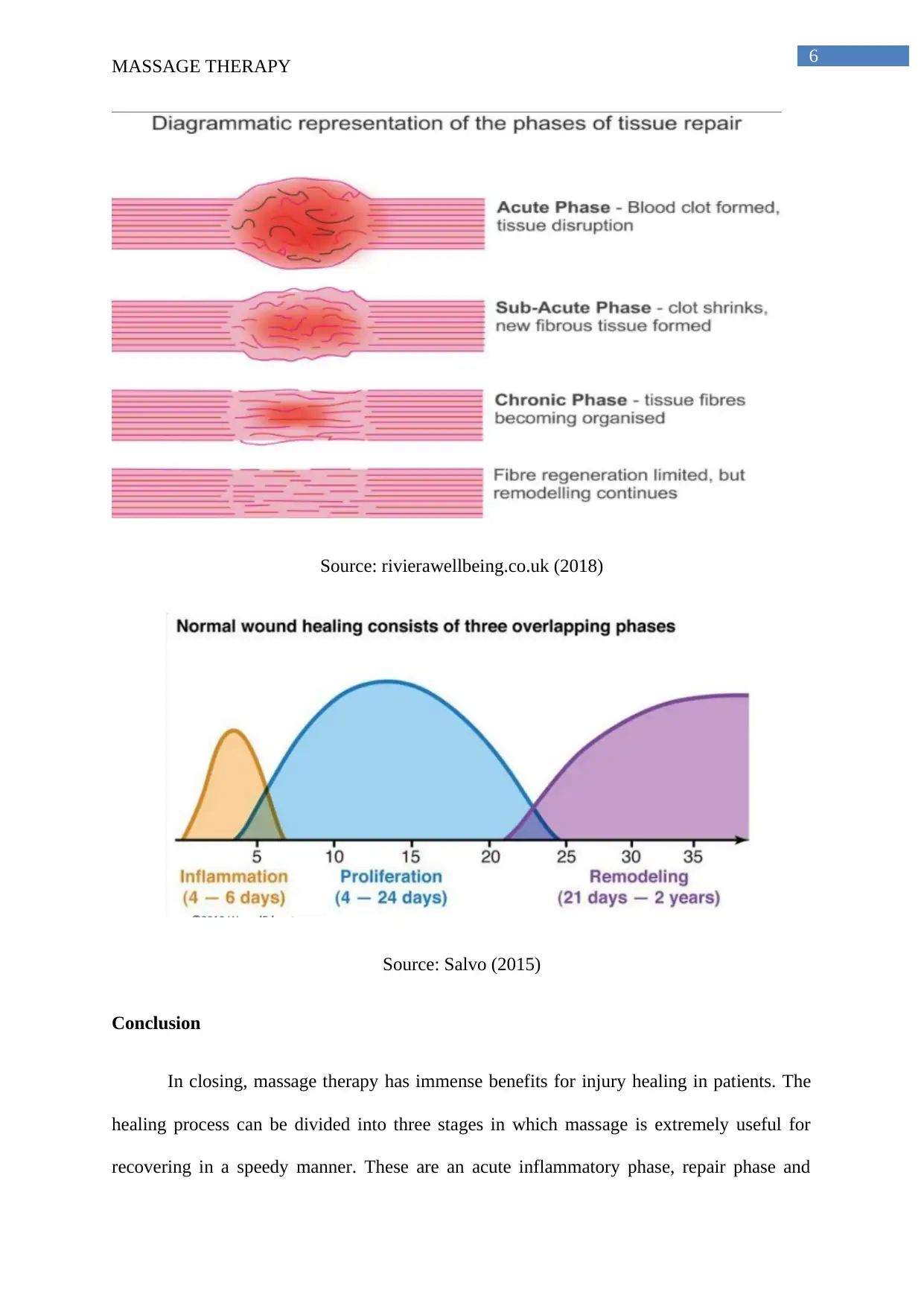
6
MASSAGE THERAPY
Source: rivierawellbeing.co.uk (2018)
Source: Salvo (2015)
Conclusion
In closing, massage therapy has immense benefits for injury healing in patients. The
healing process can be divided into three stages in which massage is extremely useful for
recovering in a speedy manner. These are an acute inflammatory phase, repair phase and
MASSAGE THERAPY
Source: rivierawellbeing.co.uk (2018)
Source: Salvo (2015)
Conclusion
In closing, massage therapy has immense benefits for injury healing in patients. The
healing process can be divided into three stages in which massage is extremely useful for
recovering in a speedy manner. These are an acute inflammatory phase, repair phase and
⊘ This is a preview!⊘
Do you want full access?
Subscribe today to unlock all pages.

Trusted by 1+ million students worldwide
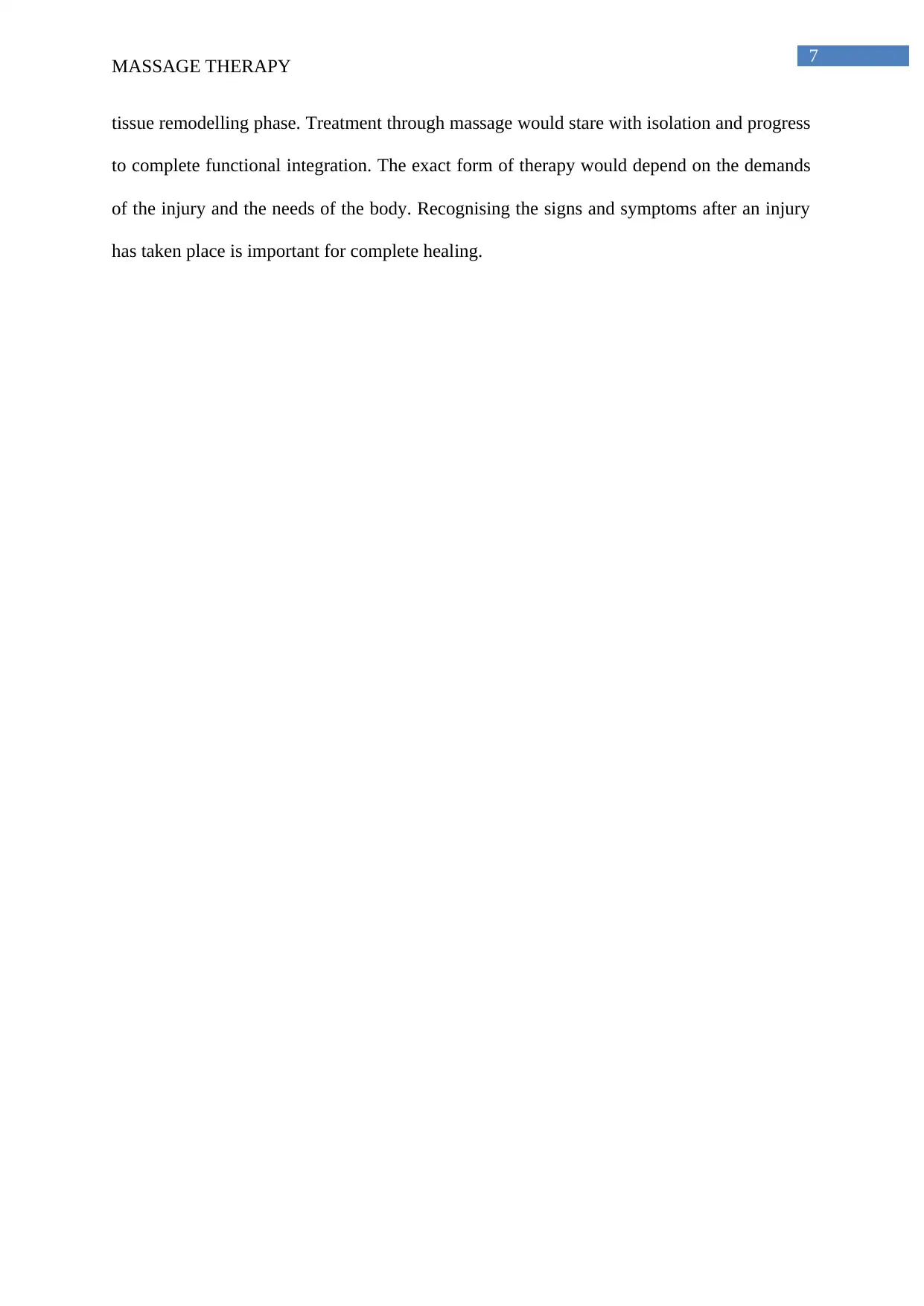
7
MASSAGE THERAPY
tissue remodelling phase. Treatment through massage would stare with isolation and progress
to complete functional integration. The exact form of therapy would depend on the demands
of the injury and the needs of the body. Recognising the signs and symptoms after an injury
has taken place is important for complete healing.
MASSAGE THERAPY
tissue remodelling phase. Treatment through massage would stare with isolation and progress
to complete functional integration. The exact form of therapy would depend on the demands
of the injury and the needs of the body. Recognising the signs and symptoms after an injury
has taken place is important for complete healing.
Paraphrase This Document
Need a fresh take? Get an instant paraphrase of this document with our AI Paraphraser
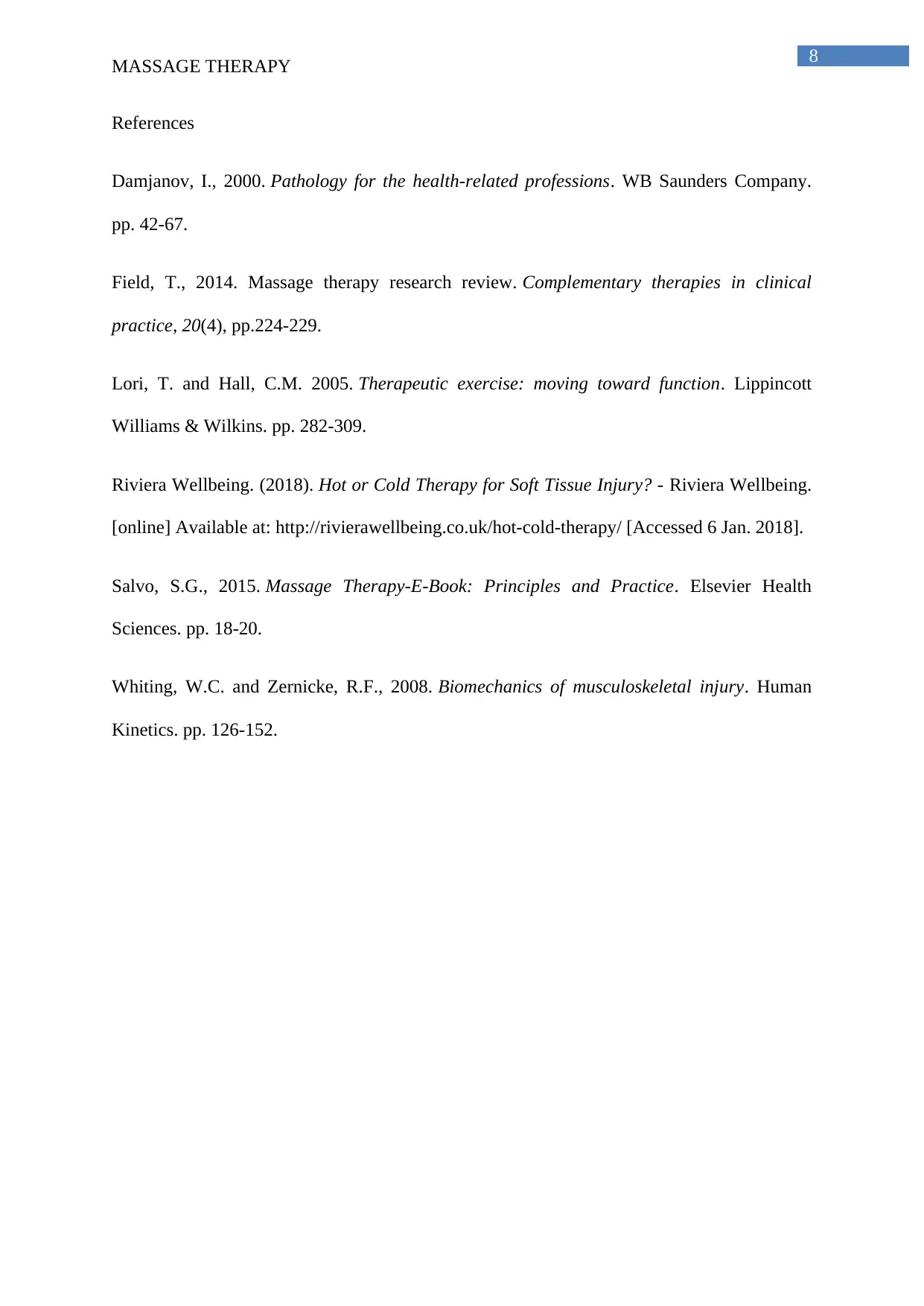
8
MASSAGE THERAPY
References
Damjanov, I., 2000. Pathology for the health-related professions. WB Saunders Company.
pp. 42-67.
Field, T., 2014. Massage therapy research review. Complementary therapies in clinical
practice, 20(4), pp.224-229.
Lori, T. and Hall, C.M. 2005. Therapeutic exercise: moving toward function. Lippincott
Williams & Wilkins. pp. 282-309.
Riviera Wellbeing. (2018). Hot or Cold Therapy for Soft Tissue Injury? - Riviera Wellbeing.
[online] Available at: http://rivierawellbeing.co.uk/hot-cold-therapy/ [Accessed 6 Jan. 2018].
Salvo, S.G., 2015. Massage Therapy-E-Book: Principles and Practice. Elsevier Health
Sciences. pp. 18-20.
Whiting, W.C. and Zernicke, R.F., 2008. Biomechanics of musculoskeletal injury. Human
Kinetics. pp. 126-152.
MASSAGE THERAPY
References
Damjanov, I., 2000. Pathology for the health-related professions. WB Saunders Company.
pp. 42-67.
Field, T., 2014. Massage therapy research review. Complementary therapies in clinical
practice, 20(4), pp.224-229.
Lori, T. and Hall, C.M. 2005. Therapeutic exercise: moving toward function. Lippincott
Williams & Wilkins. pp. 282-309.
Riviera Wellbeing. (2018). Hot or Cold Therapy for Soft Tissue Injury? - Riviera Wellbeing.
[online] Available at: http://rivierawellbeing.co.uk/hot-cold-therapy/ [Accessed 6 Jan. 2018].
Salvo, S.G., 2015. Massage Therapy-E-Book: Principles and Practice. Elsevier Health
Sciences. pp. 18-20.
Whiting, W.C. and Zernicke, R.F., 2008. Biomechanics of musculoskeletal injury. Human
Kinetics. pp. 126-152.
1 out of 8
Related Documents
Your All-in-One AI-Powered Toolkit for Academic Success.
+13062052269
info@desklib.com
Available 24*7 on WhatsApp / Email
![[object Object]](/_next/static/media/star-bottom.7253800d.svg)
Unlock your academic potential
Copyright © 2020–2025 A2Z Services. All Rights Reserved. Developed and managed by ZUCOL.





